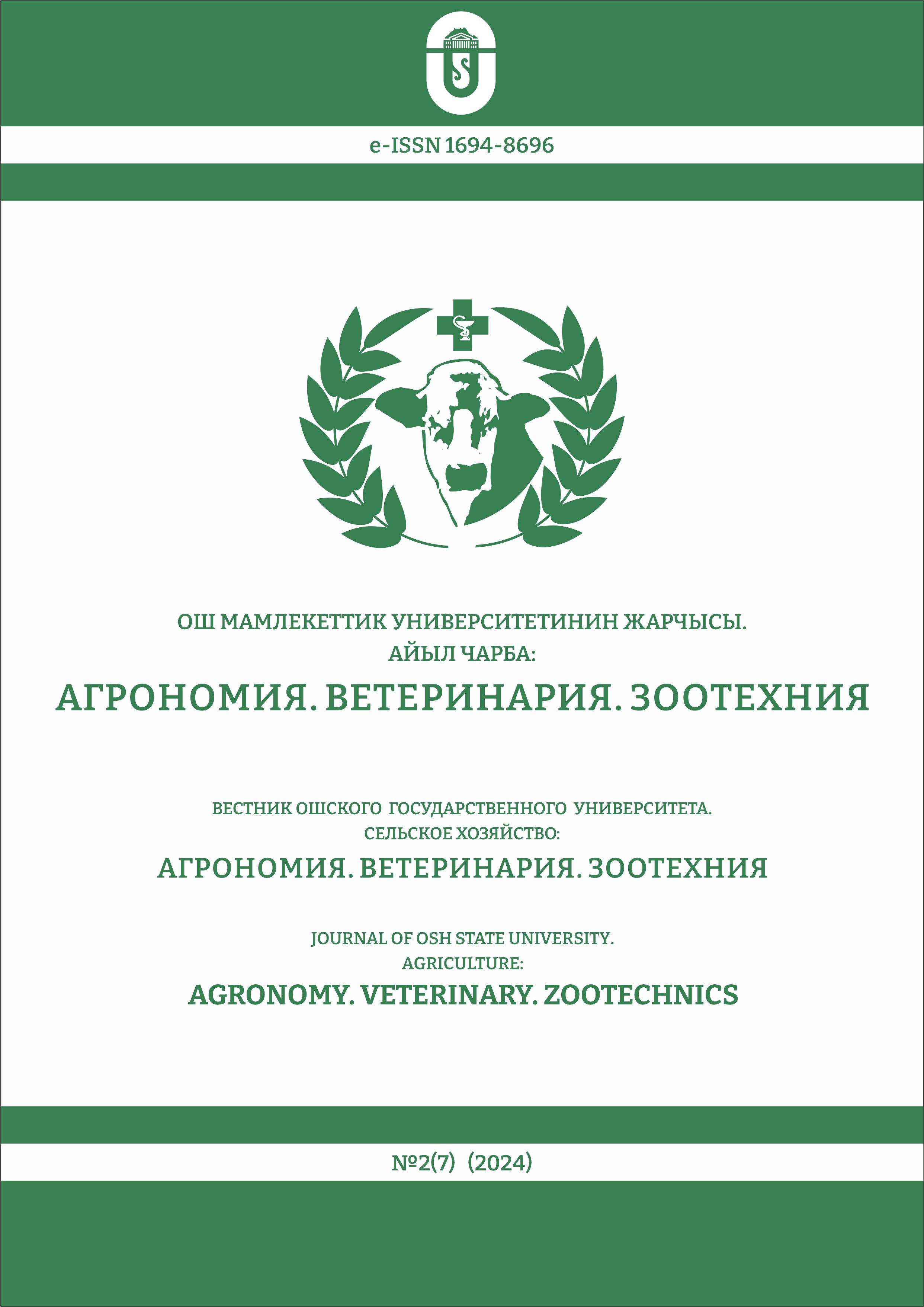THE CORRELATION BETWEEN THE HEMATOLOGICAL AND BIOCHEMICAL PARAMETERS OF THE HORSE AND RIDER IN THE LOSING KÖKBÖRÜ TEAMS
DOI:
https://doi.org/10.52754/16948696_2024_2(7)_4Keywords:
Kök-Börü, horse, rider, hematologic and biochemical parametersAbstract
In the present study, a research was planned to determine the correlation between hematologic and biochemical parameters of horse and rider in losing teams in Kökbörü, a traditional equestrian team game. For this purpose, blood samples were taken from both horses and riders of 4 different teams participating in two different Kökbörü games before and after the start of the game. Biochemistry and hematological parameters were tested using an autoanalyzer. The data obtained were then statistically analyzed according to the win-loss status between horses, riders and teams. Accordingly, negative and positive correlations were observed in many hematological parameters of the losing teams both before and after the game. In addition, there was a negative correlation between K and CK and TP levels, between AP and ALT, AST and Na levels, between Na and AP and CK levels, between Mg and ALB and CREA levels, between Cl and TP levels of the horse and rider of the losing teams before the game. There was also a negative correlation between AST and Na levels and between Mg and K levels of horse and rider after the game.
In conclusion, in the light of the data obtained, it was determined that there were both positive and negative correlations between most hematological parameters of the horse and rider before and after the game of the losing teams. However, there were negative correlations in biochemical parameters both before and after the game. This was interpreted as a negative effect of horse and rider on each other in losing stemball teams.
References
Gül M, Uzun RN, Çebi M. Türk kültürlerindeki geleneksel oyunlar ve sporlara yüzeysel bir bakış. Electr. Turk. Stud. 2018, 13, 655-671. DOI: https://doi.org/10.7827/TurkishStudies.14386
Yücel MU. Kazak Türklerinin milli oyunlardaki at yarışları. Onl. Tem. Türkol. Derg. 2010, 2, 353-375.
Kurt T, Kılıç M, Kılıç MN, Özbayraktar F, Yücel E, Kıvanç, C. Türk Spor Tarihi. Devlet Kitapları Yayınları: Ankara, 2017.
Kafkaslı, A. Türk Dünyasında Nevruz Geleneğine Toplu Bakış, Erzurum Valiliği İl Kültür Müdürlüğü’nün Konferans Kitapçığı: Erzurum, 2005.
Anderson MK, Friend TH, Evans JW, Bushong DM. Behavioural assessment of horses in therapeutic riding programs Appl. Anim. Behav. Sci. 1999, 63,11-24. DOI: https://doi.org/10.1016/S0168-1591(98)00237-8
Edenburg N. Perceptions and attitudes towards horses in European societies Equine Vet. J. 1999, Suppl., 28, 38-41. DOI: https://doi.org/10.1111/j.2042-3306.1999.tb05154.x
Waiblinger S, Boivin X, Pedersen V, Tosi MV, Janczak A, Visser K, Jones RB. Assessing the human–animal relationship in farm species: a critical review Appl. Anim. Behav. Sci. 2006, 101, 185-242. DOI: https://doi.org/10.1016/j.applanim.2006.02.001
Hausberger M, Roche H, Henry S, Visser EK. A review of the human–horse relationship. Appl. Anim. Behav. Sci. 2008, 109, 1-24. DOI: https://doi.org/10.1016/j.applanim.2007.04.015
Jaeggin S, Furst A, Auer J. Kick injuries of veterinarians during examination and treatment of horses: a retrospective study in Switzerland Schweiz. Arch. Tierheilkd. 2005, 147, 289-295.
Waran N, Casey R. Horse training. D.S. Mills, S.M. Mc Donnell (Eds.), The Domestic Horse: The Origins, Development and Management of its Behaviour, Cambridge University Press, Cambridge, 2005, pp. 184-195.
Safak T, Yilmaz O, Risvanli A, Akdeniz-Incili C. Hematological, serum biochemical results, and treatment approach of an Arabian mare with squamous cell carcinoma of the vulva-case report. Arquivo Brasileiro de Medicina Veterinária e Zootecnia, 2022, 74, 525-529. DOI: https://doi.org/10.1590/1678-4162-12632
Hinchcliff KW, Geor RJ. Integrative physiology of exercise. In: Hinchcliff KW, Kaneps AJ, Geor RJ (eds) Equine sports medicine and surgery. Saunders, St Louis, 2004, pp 3–8 DOI: https://doi.org/10.1016/B978-0-7020-2671-3.50005-2
Balogh N, Gaal T, Ribiczeynè PS, Petri A . Biochemical and antioxidant changes in plasma and erythrocytes of pentathlon horses before and after exercise. Vet Clin Pathol., 2001, 30(4), 214–218. DOI: https://doi.org/10.1111/j.1939-165X.2001.tb00434.x
Ayvazoğlu C, Kızıltpe Ş, Yaşar Ü, Yaşar ZG, Demir P, Tunc, AC. Changes in cardiac troponin I (cTnI), T (cTnT), and some biochemical parameters in Arabian racehorses after training. S. Afr. J. Anim. Sci. 2023, 53(1), 1-6. DOI: https://doi.org/10.4314/sajas.v53i1.01
Allaam M, Elseady Y, Nayel M, Elsify A, Salama A, Hassan H, Kamar A, Physiological and hemato-chemical evaluation of Thoroughbred race horse after exercise. I.J.A.V.M.S. 2014, 8, 81-93.
Kedzierski W, Bergero D, Assenza A. Trends of hematological and biochemical values in the blood of young race horses during standardized field exercise tests. Acta Vet. 2009, 59, 457-466. DOI: https://doi.org/10.2298/AVB0906457K
Bravo-Barriga D, Serrano-Aguilera FJ, Barrasa-Rita R, Habela MÁ, Chacón RB, Ezquerra LJ, Martín-Cuervo M. Effects of competitive ELISA-positive results of piroplasmosis on the performance of endurance horses. Anim. 2022, 12, 637. DOI: https://doi.org/10.3390/ani12050637
Larsson J, Pilborg PH, Johansen M, Christophersen MT, Holte A, Roepstorff L, Harrison AP. Physiological parameters of endurance horses pre-compared to post-race, correlated with performance: A two-race study from Scandinavia. Int. Sch. Res. Notices 2013, 684353. DOI: https://doi.org/10.1155/2013/684353
Jović S, Stevanović J, Borozan S, Dimitrijević B, Milosavljević P. Influence of physical activity of racehorses on lactate dehydrogenase and creatine kinase activities, and protein synthesis. Acta Vet. 2013, 63, 549-568. DOI: https://doi.org/10.2298/AVB1306549J
Merkies K, Sievers A, Zakrajsek E, MacGregor H, Bergeron R, König von Borstel U. Preliminary results suggest an influence of psychological and physiological stress in humans on horse heart rate and behavior. J. Vet. Behav. 2014, 9, 242–247. DOI: https://doi.org/10.1016/j.jveb.2014.06.003
Visser EK, Van Reenen CG, Blokhuis MZ, Morgan EKM, Hassmen P, Rundgren TMM, Blokhuis HJ. Does horse temperament influence horse-rider cooperation? J. Appl. Anim. Welf. Sci. 2008, 11, 267–284. DOI: https://doi.org/10.1080/10888700802101254
Kaiser L, Heleski CR, Siegford J, Smith KA. Stress-related behaviors among horses used in a therapeutic riding program. J. Am. Vet. Med. Assoc. 2006, 228, 39–45. DOI: https://doi.org/10.2460/javma.228.1.39
Downloads
Published
How to Cite
Issue
Section
License
Copyright (c) 2024 Ali Ришванли, Исмаил Шен, Канат Канузаков, Аскарбек Тулобаев, Тас Абузер, Руслан Салыков, Незахат Джейлан, Унал Тюрккапар, Уланбек Алимов, Айдай Джунушова, Арина Казакбаева, Нур Абдимнап Уулу, Бурак Фатих Юксел, Мерт Туранли, Мухаммед Уз, Метин Байрактар, Алпаслан Джейлан

This work is licensed under a Creative Commons Attribution-NonCommercial 4.0 International License.


